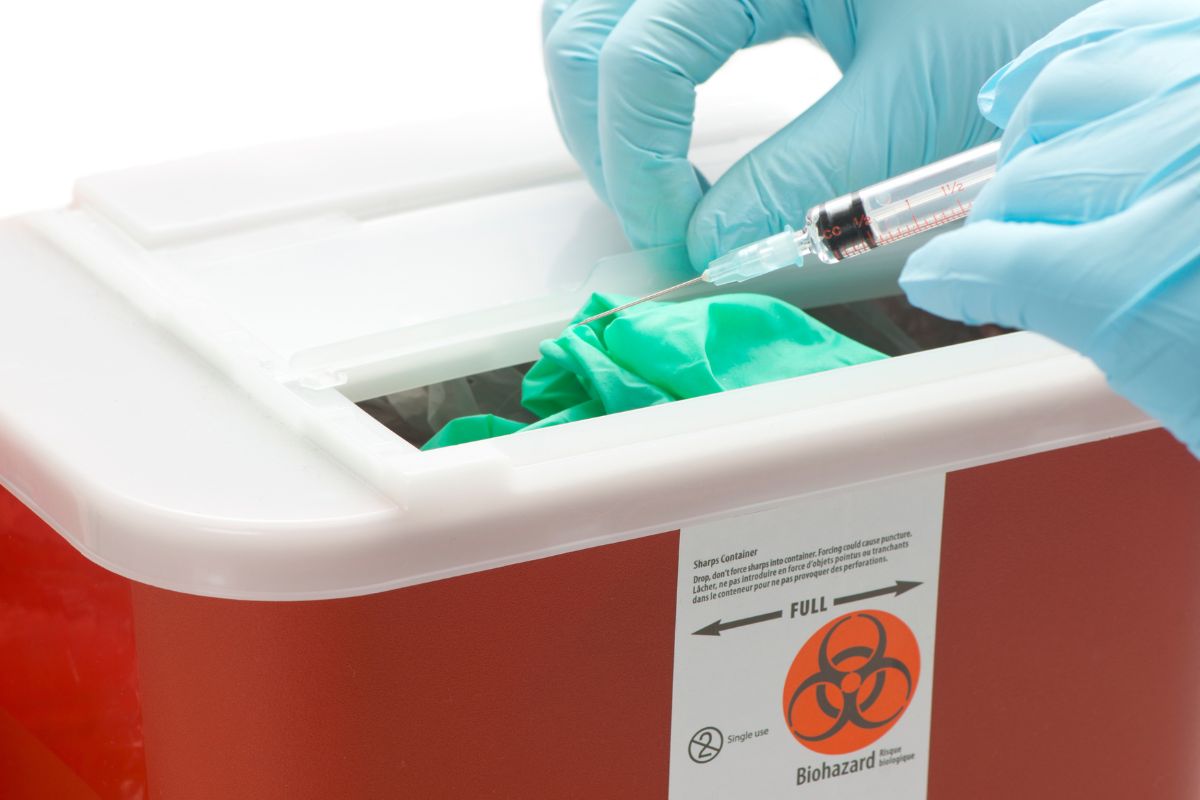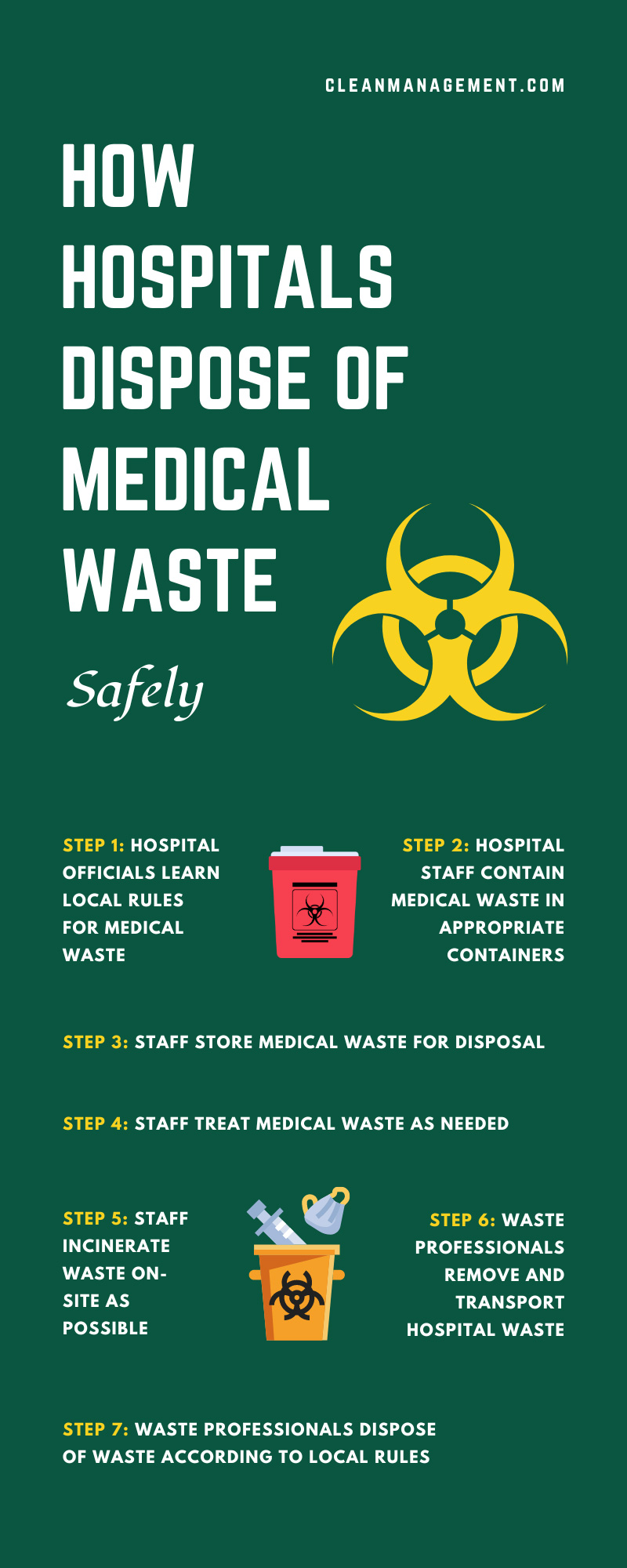How Hospitals Dispose of Medical Waste Safely

Healthcare facilities, specifically hospitals, generate a lot of waste. This amount of waste generation isn’t surprising with a full of staff serving the various needs of many patients. However, many who don’t work in the healthcare and waste management industries wonder how hospitals dispose of medical waste safely. Many questions spring from this initial wonder, such as who regulates medical waste? What treatment does medical waste require? When does the disposal actually happen? Keep reading to learn the answers to these questions and the steps hospital staff and waste management professionals take to safely dispose of waste.
Step 1: Hospital Officials Learn Local Rules for Medical Waste
In 1988, Congress enacted the Medical Waste Tracking Act (MWTA) because medical waste was washing up onto the eastern coast of the U.S. The Act allowed the U.S. Environmental Protection Agency (EPA) to regulate the management of medical waste to understand why this health hazard was occurring and how to stop it. They designed the program to last two years and only affect a few U.S. states and territories. While the program was limited, the EPA determined that medical waste poses its biggest threat upon generation. They then let states take over medical waste regulation.
Each U.S. state and territory can regulate medical waste as they see fit. Hospitals in these states and territories must learn those local regulations to properly contain, store, treat, and dispose of waste. Most hospitals partner with a local waste management company that understands these local regulations to help properly dispose of their medical waste.
Step 2: Hospital Staff Contain Medical Waste in Appropriate Containers
Hospital officials share the waste regulations with hands-on staff members such as nurses and janitors. It is important for these hands-on staff members to know what to do with medical waste as soon as the hospital generates it, such as after a nurse gives a shot or when a janitor collects a garbage bag.
Most states, and therefore most hospitals, divide waste into four categories: pathological waste, solid waste, liquid waste, and sharps waste. Staff must contain each type of waste in the appropriate container for safe collection. Generally, the appropriate container is a red, leak-resistant biohazard bag. Staff secure the top of this bag and then place it in another biohazard bag in case of contamination or other problems. Sharps waste, such as needles, generally go into puncture-resistant containers within the vicinity of the staff person using them. The staff members in charge of waste disposal then transport all these containers to another part of the hospital for storage.
Step 3: Staff Store Medical Waste for Disposal
Even though the EPA ruled that medical waste was the most dangerous at its generation, it’s important to store medical waste properly. Only authorized personnel should have access to medical waste. The medical waste itself should also pose as little risk as possible to the authorized personnel. Most states require hospitals to store medical waste in puncture-resistant, leak-proof containers with accurate labels.
Hospitals should store these labeled waste containers in a well-ventilated area and take additional precautions to prevent foul odors. Pests should not be able to access the storage facility or the storage containers. Storage is a temporary waste solution and hospitals should regularly dispose of waste to prevent accumulation and reduce the risk of danger and other problems.
Step 4: Staff Treat Medical Waste as Needed
Some hospitals can treat some of the medical waste they generate. Treating the waste within the hospital facility can save time and money and reduce accumulation. Waste treatment can kill or otherwise remove the dangers of the waste, leading to recycling or safer disposal for waste management companies.
The most popular on-site treatment option is autoclaving. An autoclave is a closed chamber system that combines pressure with heat or steam to sterilize medical tools, equipment, and sharps. They come in various sizes so hospitals of various sizes can use them. However, autoclaving or other on-site waste treatment is often not a requirement. It is simply an option that can save the hospital time and money and protect the hospital and waste management staff.
Step 5: Staff Incinerate Waste On-Site As Possible
The waste disposal staff can incinerate medical waste if autoclaving isn’t enough, and the hospital wishes to perform its own disposal method. Like autoclaving, incineration is often not a requirement. Individual hospitals can choose to add or use an incineration facility, but they do not have to.
The EPA’s Office of Air Quality Planning and Standards regulates hospital waste incinerators due to concerns about unhealthy air quality for humans. Individual states often have additional regulations, including certifications and licenses, concerning hospital waste incinerators or other technological treatments.
Step 6: Waste Professionals Remove and Transport Hospital Waste
Once hospital staff properly contain, store, and potentially treat medical waste, most call professionals to remove the waste from the facility. Waste professionals can safely gather the waste from the proper storage area and transport it for permanent disposal elsewhere. Some offer additional services including containment and storage.
Regardless of when the hospital staff contacts the waste professionals, the professionals will eventually remove and transport the waste according to federal, state, and local regulations. A good waste management company will have certified waste transportation drivers to ensure safe and efficient transportation.
Step 7: Waste Professionals Dispose of Waste According to Local Rules
After the waste professionals remove and transport the medical waste, they can dispose of it according to local rules. They may also need to keep federal and state regulations in mind. These rules and regulations make partnering with a local waste management company important. They will know the federal and state regulations and any local rules that national companies may not know about.
Disposal methods can vary depending on the type of waste and established regulations. Incineration and landfill disposal are popular, especially for medical waste. In some cases, fuel-blending and recycling are possible. The waste professionals will determine the best disposal method for the medical waste they collect.
Hospitals dispose of medical waste safely through a seven-step process that often involves waste management professionals. The professionals at Clean Management Environmental Group can help if your hospital or other medical facility requires hazardous waste transportation and disposal. Our certified drivers can safely and efficiently transport your waste. We will then handle the disposal for you so you can focus on providing a safe and healthy environment for your patients and staff.

